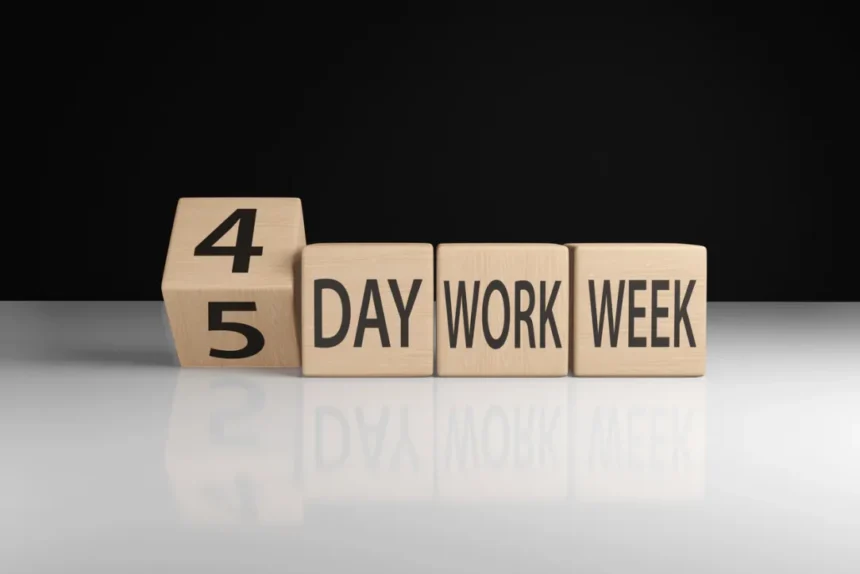The 3-day workweek sounds like a fever dream — until you see the data behind shorter weeks. Let’s unpack what a true 3-day schedule changes, where it works, and how leaders make it sustainable without torching service or revenue.
The 3-Day Workweek, Explained (and how it differs from the 4-day wave)
When people hear “shorter week,” they often picture a comfy four-day schedule (32–36 hours) — not a 3-day workweek. Here’s the quick decoder ring:
- 3-day workweek: Typically 24–30 total hours or three intense 8–10 hour days. It’s the most extreme version, usually paired with staggered coverage or shift models.
- 4-day workweek: The more common pilot — either compressed 40 hours or reduced 32 hours. Think of it as the gateway reform that proved the broader thesis.
To understand how a 3-day setup might land in the real world, it helps to read the tea leaves from the 4-day experiments that came first — the 4-day workweek boom is the closest evidence base leaders can mine right now.
What We Actually Know from Real-World Trials
Shorter weeks are not new, but the last few years created the largest natural experiments we’ve seen. The headline results are noisy, yet instructive.
Microsoft Japan’s headline result
In 2019, Microsoft Japan tested shorter weeks and reported Microsoft Japan’s 40% productivity spike along with lower energy costs and happier employees. No, it wasn’t a 3-day trial — but it validated the core mechanism: fewer days can force better prioritization, cleaner meetings, and tighter async norms.
Perpetual Guardian’s playbook
New Zealand’s Perpetual Guardian turned its pilot into policy after outcomes improved across stress, engagement, and output. It’s become a field manual for leaders contemplating radical schedules like a 3-day rotation; study Perpetual Guardian’s shorter-week case to see how expectations, metrics, and trust contracts were rewritten.
The UK’s multi-company pilot
The UK conducted one of the largest shorter-week tests to date. Continuation rates stayed high and revenue trends held steady to slightly positive. If you want cross-industry signals (professional services, marketing, manufacturing, nonprofits), comb through the UK four-day week pilot results and translate those mechanics into your own 3-day design.
How to Make Fewer Days Actually Work
Think architecture, not vibes. The organizations that sustain shorter weeks build scaffolding first, then test the schedule.
Workflow redesign, not just fewer hours
Cutting a day without changing the work is a doom spiral. You need ruthless meeting hygiene, explicit focus blocks, and a bias for asynchronous updates. Harvard Business Review offers a pragmatic checklist — worth cribbing even if you never touch the calendar — on how to actually execute a four-day workweek. For 3-day experiments, double it: decide what you’ll stop doing altogether.
Client coverage and staffing models
A 3-day rotation means someone isn’t working four days a week — that’s fine if coverage is designed. Stagger teams (A/B/C), use handoff playbooks, and align SLAs to coverage windows. If you’re already wrestling with hybrid days and hot-desking, you know the cultural tension; see the RTO tug-of-war to calibrate messaging and guardrails around return-to-office pressures and hybrid norms.
Watch: What a Shorter Week Looks Like
You saw the video above, but it’s helpful to revisit CNBC’s explainer on the four-day workweek to visualize how organizations stagger calendars, measure performance, and handle clients. Those same levers are your blueprint for any 3-day variant.
Who Should (and Shouldn’t) Try a 3-Day Workweek
Good candidates
- Project-based knowledge teams with measurable deliverables and low ticket-churn variability.
- Boutique agencies/consultancies that can align clients to set sprint windows and post work-in-progress asynchronously.
- Product orgs with strong sprint rituals and a tech stack that supports deep work and “maker” schedules.
Proceed with caution
- High-volume support or ops with strict SLAs. You’ll need staggered shifts, not universal 3-day schedules.
- Healthcare, hospitality, logistics where 24/7 coverage is table stakes — a 3-day week here is a staffing puzzle, not a perk.
- Sales teams in live markets; consider hybrid models (3 on-site selling days + 1 admin day, not strictly 3 total days).
Social Pulse: Real Reactions
“Three days on, four days off? I’d finally have time to breathe.” — a TikTok user
“Cut hours all you want — the deadlines don’t shrink.” — a Redditor
“Pilot it with staggered coverage before you make it policy.” — an X user
The Benefits (when it’s designed well)
- Focus over flailing. Less calendar encourages sharper prioritization, fewer status meetings, and more “done.”
- Morale and retention. Extra off-days act like a permanent long weekend — big for burnout recovery and hiring.
- Cost hygiene. Reduced office days can trim utilities and perks spend; travel consolidates into tighter windows.
- Brand lift. Shorter weeks are a magnet for mid-career talent and returners who’ve soured on performative busyness.
The Friction You Have to Solve
- Coverage gaps. Clients don’t care about your pilot; map contact windows and build escalation paths.
- Meeting creep. If you don’t set hard caps (count + duration), you’ll just compress the chaos into fewer days.
- Scope slippage. Fewer days mean fewer cycles — ship smaller units of value, more often.
- Equity pitfalls. Make sure frontline and care-giving employees see the same flexibility fruits as HQ roles.
Designing a 3-Day Pilot: A Practical Blueprint
- Name your schedule archetype. Three 10s? Three 8s? Rotational coverage? Write it down.
- Pick the right unit. Don’t start company-wide. Choose one team with stable demand and supportive stakeholders.
- Define your SLAs. What promises do you make to clients/partners? When are you live? Who’s the on-call?
- Rewrite meetings. Cap total weekly meeting time per person. Kill recurring meetings without owners or agendas.
- Instrument outcomes. Track throughput, quality, customer NPS, employee eNPS, and revenue per hour.
- Publish norms. Focus hours, doc-first updates, response windows, and handoff rituals.
- Run for two cycles minimum. One sprint won’t surface seasonality or end-of-quarter crunch behaviors.
- Hold a blameless retro. If something breaks, fix the system, not the people.
- Decide expand/iterate/stop. Expansion requires proof: stable KPIs and a coverage pattern you can repeat.
What 3 Days Changes in Practice (mini case insights)
- Sales engineering: Switch from ad-hoc demos to “live demo blocks” on coverage days; record and circulate.
- Product design: Protect one full “maker day” with zero meetings; gate PRDs via async review to avoid calendar ping-pong.
- Customer success: Create “office hour” windows and a transparent ticket triage board so clients know when they’ll hear back.
- Finance & ops: Consolidate approvals and closes into standardized “runways” — e.g., Wednesday close, Thursday review.
Metrics That Matter (and ones to ignore)
Watch closely: cycle time, throughput, error rates, customer satisfaction, employee burnout signals, and revenue per labor hour.
Ignore at first: raw Slack/Teams message volume, desk occupancy, or arbitrary “online” time. Large swings mean your culture is adapting; judge outcomes, not keystrokes.
The Culture Equation
The calendar is just a mirror. If your org defaults to “more meetings = more work,” a 3-day trial will collapse under legacy habits. If you reward outcomes, write things down, and respect focus time, the 3-day workweek becomes a forcing function for everything you’ve wanted to fix since 2019.
Fast-Start Checklist for Leaders
- Commit to a written pilot charter and timeline.
- Publish SLAs and coverage windows to customers.
- Cap meetings and enforce maker blocks.
- Move status to async dashboards.
- Track a small set of outcome metrics weekly.
- Run retros; adjust scope, not promises.
- Decide based on data, not vibes.
FAQ
How does a 3-day workweek impact productivity?
When designed with meeting caps and clear SLAs, a 3-day workweek can sharpen focus and throughput, echoing lessons from Microsoft Japan’s 40% productivity spike and broader pilots.
Are there industries where a 3-day workweek isn’t feasible?
Yes. Continuous-service sectors (healthcare, hospitality, logistics) need staggered shift models. Use insights from the UK four-day week pilot results to design coverage without burning teams out.
What are the potential downsides of a 3-day workweek?
Coverage gaps, meeting compression, and scope slip. Study how to actually execute a four-day workweek and apply those mechanics more aggressively for a 3-day variant.
Why are companies considering a 3-day workweek?
Recruiting power, retention, and cost hygiene — plus the cultural momentum from the 4-day workweek boom that normalized experimenting with time.
How do hybrid and office expectations interact with a 3-day week?
Be explicit about in-office vs. remote days and handoffs. See return-to-office pressures and hybrid norms for the context your employees are already living in.









